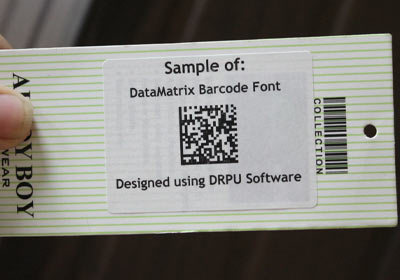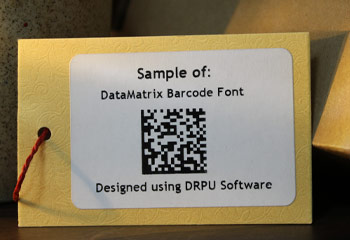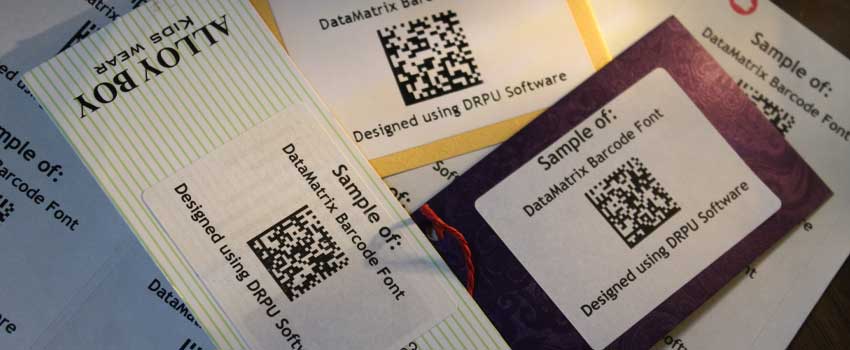Applications of DataMatrix Barcode
DataMatrix barcodes are used in a wide range of industries and applications, including:

1 Retail : DataMatrix barcodes are used on products in retail stores to encode product information, pricing, and other details.
2 Government : DataMatrix barcodes are used in passports and other identification documents to encode personal data and prevent fraud.
3 Manufacturing : DataMatrix barcodes are used to track and trace parts and components through the manufacturing process, ensuring quality control and preventing counterfeiting.
4 Healthcare : DataMatrix barcodes are used to encode patient data, medication information, and other healthcare-related information.
5 Logistics management : DataMatrix barcodes are used to track and trace products through the supply chain, from manufacturing to distribution to retail.
In conclusion, the DataMatrix barcode is a two-dimensional barcode that can encode a large amount of data in a small space. It is widely used in a range of industries and applications, including logistics, healthcare, manufacturing, and more. The advantages of DataMatrix barcodes include high data capacity, robustness, readability, flexibility, and security.
Limitations Of Using DataMatrix Barcodes
DataMatrix barcodes have several advantages over other types of barcodes, such as their high data density, error correction capability, and small size. However, like any technology, there are also limitations to their use. In this answer, we will discuss some of the limitations of DataMatrix barcodes.
-
Limited Data Capacity:
While DataMatrix barcodes can store more data than traditional linear barcodes, they have a limited data capacity compared to other 2D barcodes such as QR codes. This can be a limitation for businesses that require the storage of large amounts of data in a single barcode.
-
Limited Compatibility:
DataMatrix barcodes can be read by most 2D barcode scanners, they are not always compatible with legacy systems that only support linear barcodes. This can be a limitation for businesses that have already invested in barcode scanning technology that supports linear barcodes.
-
Limited readability in
certain environments:
DataMatrix barcodes may not be readable in certain environments, such as those with extreme temperatures or in areas with high levels of dust or debris. In these cases, other types of barcodes may be more suitable.
-
Limited international
standards:
DataMatrix are widely used in the United States, they are not as widely recognized as some other types of barcodes in other countries. limitation for businesses that operate globally and require a standardized barcode.
-
Limited printing options:
DataMatrix barcodes require a high level of printing quality to be accurately scanned. Low-quality printing can lead to difficulty scanning or decoding the barcode. Barcode reflective or metallic surfaces, making the barcode difficult.
-
Limited use for human-readable information:
While DataMatrix barcodes can encode text, they are primarily designed for machine-readable data. This means that the use of DataMatrix barcodes for human-readable information such as product names or pricing may be limited.
-
Limited scanning distance:
DataMatrix barcodes have a limited scanning distance compared to other types of barcodes. The scanning distance depends on the size of the barcode and the scanner used. Smaller DataMatrix barcodes can only be scanned at a shorter distance, while larger ones can be scanned from a greater distance. This can make it difficult to scan DataMatrix barcodes that are located in hard-to-reach areas or on large items.
📝 Summary DataMatrix barcodes have several advantages over other types of barcodes, such as their high data density and error correction capability. However, there are also limitations to their use, such as limited scanning distance, limited compatibility with legacy systems, limited printing options, limited data capacity, limited international standards, limited readability in certain environments, and limited use for human-readable information. It is important for businesses to carefully consider these limitations when choosing a barcode system.
Size Of DataMatrix Barcode
DataMatrix is a two-dimensional barcode that was developed in the early 1990s by the company Acuity CiMatrix (now owned by Siemens). Unlike traditional linear barcodes, DataMatrix encodes information in both the horizontal and vertical directions, allowing it to store significantly more data in a smaller space. In this section, we will explore the size of DataMatrix barcodes and how it is determined.

➽ The size of a DataMatrix barcode is determined by the module size, which is the size of each individual square module that makes up the barcode. The module size is typically measured in mils (1 mil = 0.001 inch) or micrometers (μm). The smaller the module size, the more information that can be encoded in the barcode.
➽ For example, a DataMatrix barcode with a module size of 10 mils can store up to 155 alphanumeric characters, while a barcode with a module size of 20 mils can only store up to 36 alphanumeric characters. This means that if you need to encode a lot of information in a small space, you will need to use a smaller module size.
✧ Barcode Size➽ The size of the overall DataMatrix barcode is determined by the number of modules that are required to encode the data. Each module can be either black or white, representing a binary 1 or 0. The number of modules required depends on the amount of data that needs to be encoded, as well as the error correction level (ECL) that is used.
➽ The ECL determines how much redundancy is added to the barcode to ensure that it can still be read even if it is damaged or partially obscured. The higher the ECL, the more redundant information is added to the barcode, which means that more modules are required to encode the data.
➽ For example, a DataMatrix barcode that encodes 100 alphanumeric characters with an ECL of 10% will require a minimum of 26 x 26 modules, assuming a module size of 10 mils. However, if the ECL is increased to 40%, the barcode will require a minimum of 34 x 34 modules. This means that the overall size of the barcode will be larger.
✧ Printing Considerations➽ The size of a DataMatrix barcode can also be influenced by the printing process and the materials that are used. In order to be read accurately, the barcode must be printed at a high resolution and with high contrast. This means that the bars and spaces of the barcode must be sharply defined and easily distinguishable from one another.
➽ If the barcode is printed poorly or on a low-quality printer, the bars and spaces may blend together or become distorted, which can make the barcode unreadable. In addition, the size of the barcode may be affected by the materials that it is printed on. For example, if the barcode is printed on a curved surface, the bars and spaces may need to be adjusted to ensure that they remain sharp and well-defined.
✧ Application Considerations➽ The size of a DataMatrix barcode can also be influenced by the specific application for which it is used. For example, if the barcode is used to label small electronic components, it may need to be small enough to fit on the component without obstructing any other information. In this case, a smaller module size may be required in order to encode the necessary information.
➽ On the other hand, if the barcode is used to label larger items, such as pallets or shipping containers, a larger module size may be used in order to ensure that the barcode is easily readable from a distance. In addition, the ECL may need to be increased in order to ensure that the barcode can still be read if it becomes partially obscured or damaged during transport.
Advantages Of Using DataMatrix Barcode

➦DataMatrix barcodes offer a number of advantages over other types of barcodes. In this response, we will explore some of the key advantages of using DataMatrix barcodes.
Download and Install Barcode Software
📝 Summary DataMatrix barcodes offer a range of advantages over other types of barcodes, including high information density, high reliability, small size, high-speed reading, versatility, security, flexibility, lower printing costs, and easy integration. These advantages make DataMatrix barcodes ideal for a wide range of applications in a variety of industries.